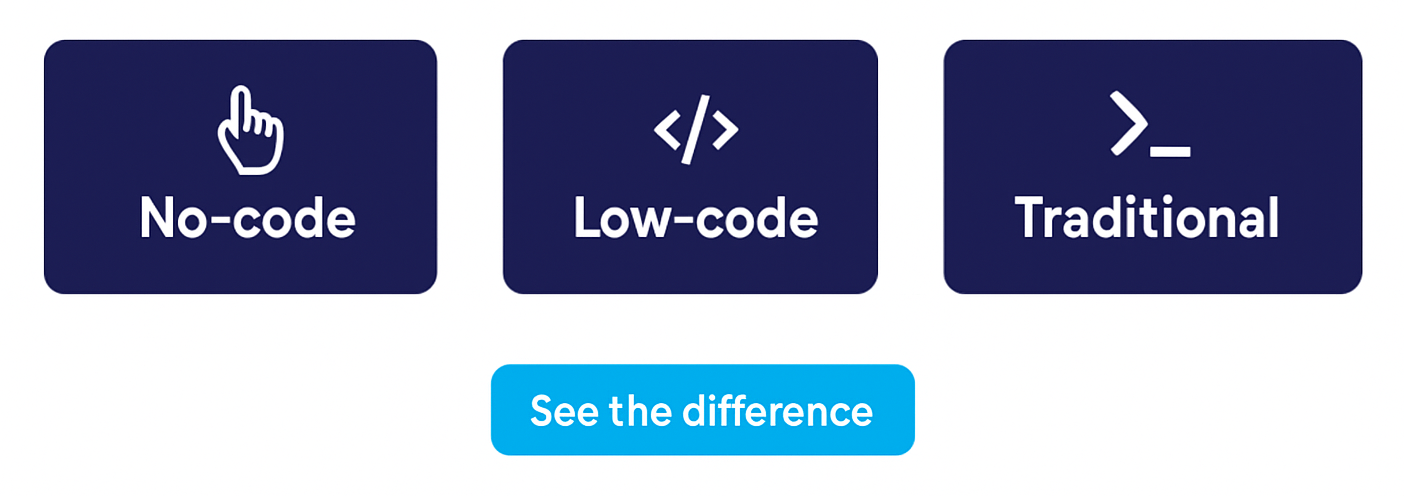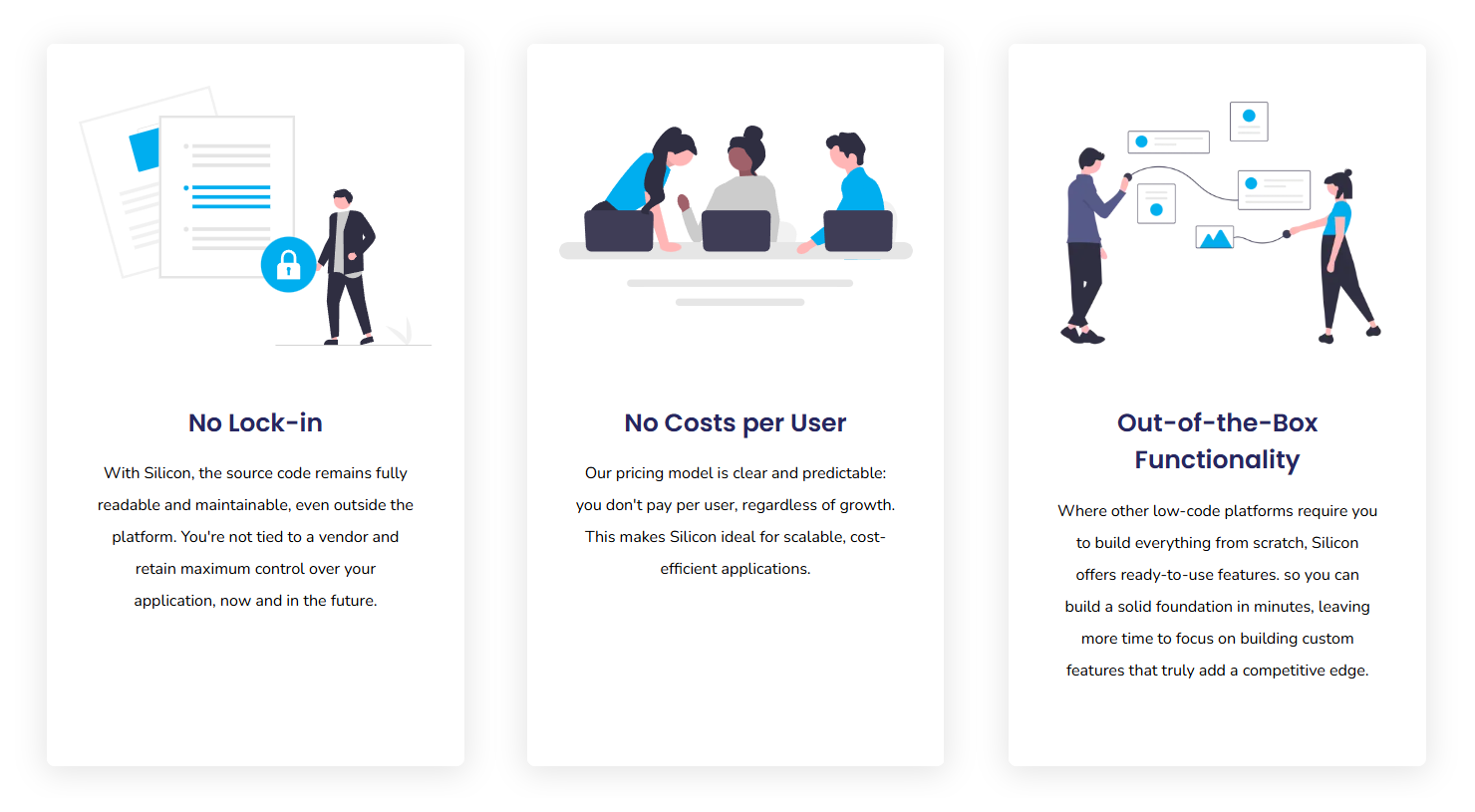When developing a web application, there are several services to choose from: no-code, low-code, high-code and platforms such as Microsoft Power Apps. Depending on the complexity of the desired solution and the available resources, an organization can choose different development methods.
In this blog, we compare these development services and highlight the problems that each method encounters, which motivated us to build our own low-code platform tackling these issues. Are you looking for a quick way to compare the different web application development services?
Take look at the comparison table

No-Code tools: for creating simple web applications
With no-code platforms, users build web applications themselves, without needing any programming knowledge. Simple applications can be quickly 'clicked' together via a visual interface and drag-and-drop components.
Advantages:
- Fast development for simple web applications.
- Very accessible for non-technical users.
Disadvantages:
- Limited flexibility (not suitable for complex web applications).
- Possible limitations in integration with existing systems.
Low-Code tools: for custom web applications
Low-code platforms combine the visual development that you also see with no-code with the possibility of adding custom code. This makes them suitable for building more complex web applications because users are not stuck with a limited number of standard 'blocks'.
Advantages:
- Accelerated development thanks to the reusable components.
- Suitable for collaboration between developers and business users.
Disadvantages:
- Limitations in full adaptability of the generated code.
- High dependency on the vendor (vendor lock-in).
- License costs can increase due to licensing models with costs per user.
Traditional development (High code): for complete control of web applications
High code, or traditional software development, means web applications are built entirely with code. This of course offers maximum flexibility, but also requires considerable development time, multiple developers and a lot of maintenance time afterwards.
Advantages:
- Full control over the functionality and architecture of the web application.
- No dependency on specific platforms or suppliers.
Disadvantages:
- Development processes that often take a long time and subsequent high costs.
- Requires multiple specialized developers with in-depth knowledge.
Silicon Low Code: The ideal business web application development service
In our own Silicon Low Code platform, we combine the advantages of traditional development methods with the speed and flexibility of low-code platforms. What sets Silicon apart is the combination of standard functionalities, a clear pricing model and the absence of the notorious vendor lock-in.
Standard functionalities that accelerate web application development
Where other low-code platforms have everything built from scratch, Silicon offers hundreds of immediately deployable standard functionalities. In just a few minutes, we create a solid foundation for a working application. These standard components ensure that developers have the time to focus on specific business logic that really adds value.
Silicon also addresses a number of other shortcomings of the aforementioned methods, making it a unique solution for complex, scalable web applications.
- No vendor lock-in: The source code remains fully readable and customizable, allowing organizations to retain maximum control over their web application.
- Developer-driven: The platform is designed with developers in mind, making customization and integration with existing systems easy.
- High performance: Through efficient code generation, Silicon delivers Low Code web applications that are truly high-performance, and will continue to be so.
- Cost-efficient: Transparent pricing model with no hidden costs per user, allowing budgets to remain predictable when developing a web application, even as the organization grows.
With Silicon Low Code, organizations can quickly and efficiently have a professional web application created that meets their specific needs, without encountering the well-known disadvantages of the major American low-code platforms or development methods such as no-code and high-code.

Choosing between web application development services? Take a look at this FAQ
When do I choose no-code instead of low-code when having a web application created?
No-code is especially suitable for simple web applications where speed and accessibility are paramount. Think of simple mobile apps, internal tools or forms that are built by non-technical employees. Low-code, on the other hand, is better for more complex applications where customization and integrations are required.
Are web applications developed with low-code secure?
Good low-code platforms, such as Silicon Low Code, are designed with enterprise security in mind. They offer role management, encryption and audit trails to comply with regulations such as the GDPR. Always check whether the platform specifications meet the requirements of your organization.
Can I implement complex business logic in a web application with low-code?
Absolutely. Silicon Low Code supports adding your own code, allowing developers to retain full control over complex business processes. The standard components speed up the process, but do not limit the possibilities.
How scalable is a low-code developed web application?
It depends on the platform. Silicon Low Code generates efficient and clean code, which contributes to excellent performance and scalability. This makes web applications easy to expand as the organization grows.
How much does a low-code platform cost if I want to have a web application created?
Many low-code platforms charge per user, which can quickly increase costs. Silicon Low Code offers a transparent pricing model without per-user costs, which is beneficial for growing organizations.
Compare the different development services
Thanks to this comparison of web application development services, you will gain insight into which method best suits the needs of your organization. Whether you choose no-code, low-code, high-code or a platform such as Microsoft Power Apps, it is essential to carefully weigh the pros and cons. Silicon Low Code offers a combination of speed, flexibility and control, making it an excellent choice for organizations that want to have a complex web application created that is suitable for system integration with external tools.

For more information on how Silicon Low Code can support your organization in developing custom web applications, please contact us for a free demo.
Get in touch now
















